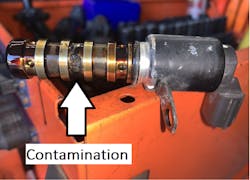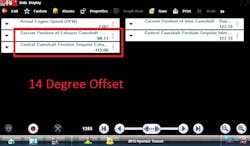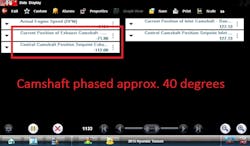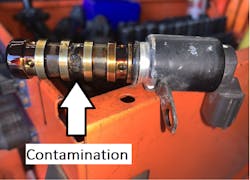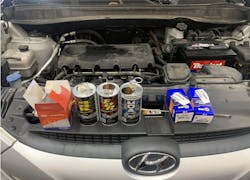I’m not sure what it is about Hyundai vehicles that come into our shop, but it seems like every one of them that shows up for service is at their first appointment ever. I know that Hyundai is having their fair share of problematic engines, especially on their Gasoline Direct Injection (GDI) platforms, but I just cannot accept it’s all on the manufacturer. In my experience, it is almost an everyday occurrence that the engine is out of oil, the oil filter is not a factory filter, and the air filter is 100 percent restricted, yet somehow these engines are getting warrantied when the connecting rod is sitting on the ground from obvious lack of maintenance.
I have heard two different theories on their engine failures:
- Low speed pre-ignition (LSPI)
- Metal left in the blocks during machining
Low-Speed Pre-Ignition (LSPI)
When I first heard of LSPI, more commonly known as mega knock, I was sitting in a class by Automotive Seminars presented by John Thornton. I think all of us in the class were taken aback by this little-known phenomenon. What I remember from the class is LSPI is difficult to detect, and it’s significantly more violent than a typical spark knock concern.
This type of knock is associated with turbo GDI applications but also affects non-turbo GDI engines as well. I know Hyundai/Kia has offered software updates to aid in reducing this condition, but tuning the engine will not eliminate all concern. Manufactures are still struggling to maximize power output on GDI platforms because of the problems presented with LSPI.
Another aid has been developed to help minimize this phenomenon. There is a new engine oil additive that has been engineered and will be purpose fitted into the ILSAC gf-6 spec of engine oils. For consumers out there who think the $19.99 oil change special is a quality service for your GDI vehicle, I’d seriously reconsider a more reputable service center. Luckily for this customer, they managed to get the last year available for the Tucson without a GDI application. Otherwise, they may have already needed an engine or two (Figure 1).
The issue exhibited
A 2013 Hyundai Tucson with 70,000 on the odometer came to our shop with a start stall condition as well as a check engine light. I performed an auto scan and found a p0017 in the engine controller. I noticed the oil change sticker was well overdue by mileage.
I confirmed the concern and sure enough the engine would start and stall. If I added some pressure to the gas pedal, I could get the engine to continue to run off idle. The idle quality was terrible, but as I increased engine speed, the engine ran well. To my surprise, there was oil in the engine, and it didn’t sound like it was going to explode.
I had an idea about what was wrong with the vehicle from simply manipulating the gas pedal and understanding the nature of the DTC stored in the PCM. I thought that a cam jumped time or a cam phaser was stuck outside of its normal default/base position. This came to mind because when I was in the driver's seat (being mindful of the symptoms the engine presented), I was reminded of what a stuck open EGR valve felt like.
I decided that I need to back up my hypothesis with some relevant scan data. I'm thankful that some manufactures saw the need for accurate cam timing PIDs and answered the call. It seems like some manufactures are embracing the need to have accurate numbers regarding cam position while others severely lack capability.
When a DTC sets on a GM vehicle, the numbers are replaced with zeros. I am baffled at why any manufacturer would think that would be a useful way to deal with cam timing PIDs.
In my experience, when dealing with exhaust camshaft position PIDs, they usually incorporate a minus sign (-), whereas intake camshaft position PIDs reflect positive integers in the PID value (although, I have seen a couple of curveballs that don't apply to that last statement). I have seen on VW/Audi products that when an intake cam has jumped into a retarded position a (-) can show up before the intake PID value. This is a dead giveaway that you have a mechanical problem. There are typically two possibilities that cause this:
- A cam reluctor has shifted on the camshaft
- The cam is retarded past its set point
As I started to work through this customer's concern, I had two questions in my head that I wanted answers to:
- When the PCM commands the exhaust cam to move, how does that impact the numerical value? In other words, does the value go more negative or positive?
- What are the total cam phase degrees?
Knowing the total cam phase degrees can support theories on what component may be faulty. This is particularly applicable when a cam phaser has moved to its max travel. On a V-engine design, it's much easier to obtain known-good specifications if the problem is associated with one bank. The reason being is that we have a whole other side of the engine for analysis (the unaffected bank will give you something to compare to).
On a four-cylinder engine, this can raise the level of complexity as there is no known-good to compare to. Sometimes we can get lucky and find that the intake cam phaser, and the exhaust cam phaser have the same degree of travel. In the case for this Hyundai, there is a 10-degree difference in cam phase capability between both camshafts.
In my experience, when a cam timing DTC is set, we typically don't have phase control in our bidirectional tests (PCM will not allow). I can only imagine that manufacturers do this deliberately, so a collision cannot occur between valves or pistons. After clearing the DTC, the code immediately resets, so I had to get a little bit dirty to get answers to the questions I have.
As I pulled up my cam data PIDs, I saw a set point PID of what the PCM desired, and I saw a PID indicating what the actual position was. There was a 14-degree discrepancy (the difference between the -112 degrees “desired position” and the -98 degrees “actual position”). I suspected the numbers were not going to match based on how it was running (Figure 2) . This didn't tell me if the cam moved into the desired direction of travel or the opposite way. If I knew which direction in the numerical scale was “retarded” or “advanced,” I could rule out a mechanical failure a lot sooner.
Time to get dirty
In my next test, I full-fielded the exhaust solenoid and phased the cam as far as it would go (Figure 3) . What I saw was that the cam actual value goes from -98 degrees to -71 degrees (That answers my first question, as well as my second!). The set point being -112 degrees, and the maximum retarded position is -71 degrees. (This equates to roughly 40 degrees of phase-angle).
Since the cam moved in the direction that the PCM would normally move it in, I suspected that the cam solenoid valve may not be returning to its resting position. Some other possibilities include:
- The camshaft phaser has a mechanical issue
- The chain jumped one link
- There is a hydraulic failure in the engine, outside of the solenoid
Like I have heard Brandon Steckler say often, "Let's reach for the low-hanging fruit." A known-good cam/crank correlation waveform is available in the service information from the manufacturer. That also meant I had to get my scope and hook it up to the car. I felt confident that I could accurately diagnose this vehicle’s fault.
The exhaust cam solenoid on this engine is very accessible. I removed the solenoid for physical examination. When I took it out, I saw how neglected this engine was. The solenoid was contaminated with oil deposits and carbon (Figure 4). When I shined my light through the solenoid oil passages, I could tell the solenoid valve wasn’t returning to its resting position. I used a can of brake cleaner and an air gun to clean the solenoid out. I used my jump pack and powered the solenoid quite a few times. This allowed the valve to return to its resting position.
I installed the solenoid back into the engine and boom! The engine started and ran fine at idle. I noticed as well that my cam timing desired and actual PIDs agree (Figure 5) .
This car isn't fixed yet because I still have not addressed the root-cause of the problem. If I allow the customer to leave with the car right now, without servicing the oil, a comeback was sure to follow. I recommended the service advisor suggest the replacement of both cam timing solenoids, and A BG EPR oil change service.
BG EPR is a chemical supplement that is added to the engine oil before the oil change is performed. This chemical is engineered to break down sludge and release stuck piston rings and de-gunk other engine internal components. I have personally seen some truly fantastic results after performing this service (Figure 6) .
When I perform a BG EPR service, I like to actuate the solenoids. Doing this helps clean them out and get engine oil/chemical into the cam phasers. BG does not recommend driving the vehicle or raising the engine rpm past 1200 with this product in the oil because it can significantly dilute the engine oil and cause bearing wear or damage.
Since we are a professional shop, we understand the value in using quality parts and materials. We always install a factory oil filter on the engines that have experienced repeated mechanical failures. Hyundai has also released technical service bulletins advising on engine knocking noises associated with aftermarket filters. Oil changes are not very profitable in most circumstances, but it's not worth blowing up an engine to save a few dollars on a cheaper oil filter.
The more time I’ve spent in this industry, the more I have come to desire quality parts. To find quality, our parts are more frequently sourced from the dealership. There are some instances where an aftermarket part outperforms the OE, but I often request an OE part, especially if we had issues with aftermarket parts with certain application.The longer the suggested labor time is for a part replacement, the more likely I desire to put an OE part in the vehicle. I couldn't imagine performing a 15-hour heater core replacement and using the cheapest component you can get your hands on, only to need to disassemble the entire vehicle again, due to a part failure. This is not just the warranty labor-time you are eating. All the production lost from other jobs you could be profitable on is compounded.
In this case for this Hyundai, the labor-time for an oil control valve is 0.5 hours. Many times, I do not have any control over where the part comes from, I can only suggest.
Afterall, businesses exist to be profitable. I think this is often a source of frustration for professional technicians. We desire to give the best quality repair to the customer and gain the maximum efficiency for both ourselves and the shop.
After I performed the oil/filter change, I replaced both oil control valves. I cleared out the fault codes and drove the vehicle out of the bay, for a final road test. Shortly after driving, the malfunction indicator lamp came on, which meant I headed back to the shop to grab my scan tool and scan for DTCs. This is what was stored: P0080 -Exhaust cam solenoid circuit high.
I was thinking to myself that I remembered plugging the connector in, but I wanted to recheck my work. I examined the solenoid and found the connector fully seated. I removed the connector, plugged it in and it felt normal to me. I approached the service counter and advised them to order the solenoid from the dealership. I felt confident that this would fix it because the original solenoid didn't have a circuit fault (Just applying some logical thought to the situation).
I removed the replacement solenoid from the engine and found one of the male terminals bent up in the solenoid connector cavity. I have seen this a few times in the past. The only thing I could think of that would cause this issue is someone attempting to mate the connector incorrectly.
If the connector doesn't easily seat, there is probably a valid reason. I told the service advisor that I wouldn't recommend bending the terminal back because it is difficult to ensure a proper connection between the male and female terminals. We installed the OE part from the dealer, and the vehicle has not been back.
With a firm understanding of how the hydraulic portion of the VVT system functions, my instinct allowed me to visualize what was wrong with the vehicle. Without taking the time to familiarize ourselves with the systems we work on, we often begin our analysis far from the actual fault and as a result, invest a lot of unnecessary time. In this case, I had to use the scope to prove what was wrong with the vehicle (not that there is any wrong in going that route, but I’d always prefer to remain efficient as well as accurate).
The moral of the story is to take the time to learn about the ins and outs of the systems and components we face daily. Familiarize yourself with the tools you have and learn what they can and cannot show you. Your accuracy is likely to increase, just like your profitability and confidence!
